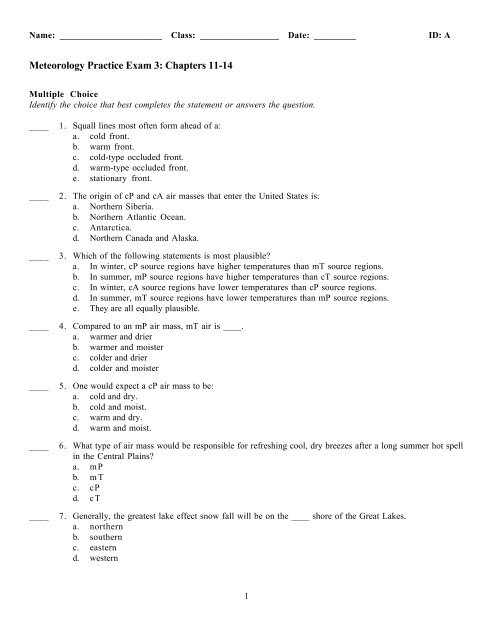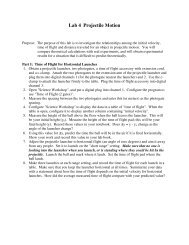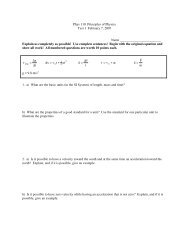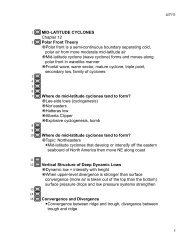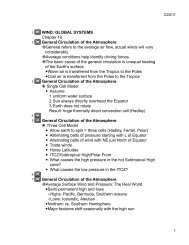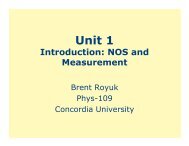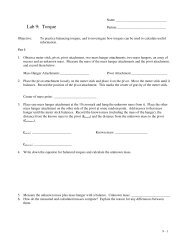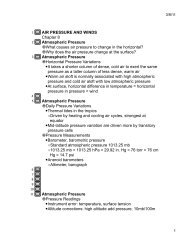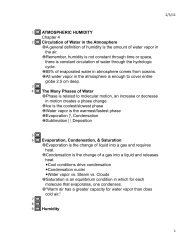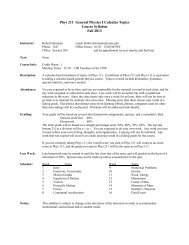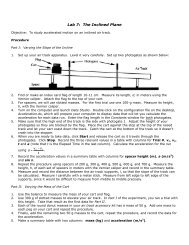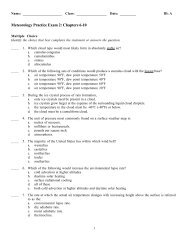Meteorology Practice Exam 3: Chapters 11-14
Meteorology Practice Exam 3: Chapters 11-14
Meteorology Practice Exam 3: Chapters 11-14
Create successful ePaper yourself
Turn your PDF publications into a flip-book with our unique Google optimized e-Paper software.
Name: ______________________ Class: _________________ Date: _________ ID: A<br />
<strong>Meteorology</strong> <strong>Practice</strong> <strong>Exam</strong> 3: <strong>Chapters</strong> <strong>11</strong>-<strong>14</strong><br />
Multiple Choice<br />
Identify the choice that best completes the statement or answers the question.<br />
____ 1. Squall lines most often form ahead of a:<br />
a. cold front.<br />
b. warm front.<br />
c. cold-type occluded front.<br />
d. warm-type occluded front.<br />
e. stationary front.<br />
____ 2. The origin of cP and cA air masses that enter the United States is:<br />
a. Northern Siberia.<br />
b. Northern Atlantic Ocean.<br />
c. Antarctica.<br />
d. Northern Canada and Alaska.<br />
____ 3. Which of the following statements is most plausible?<br />
a. In winter, cP source regions have higher temperatures than mT source regions.<br />
b. In summer, mP source regions have higher temperatures than cT source regions.<br />
c. In winter, cA source regions have lower temperatures than cP source regions.<br />
d. In summer, mT source regions have lower temperatures than mP source regions.<br />
e. They are all equally plausible.<br />
____ 4. Compared to an mP air mass, mT air is ____.<br />
a. warmer and drier<br />
b. warmer and moister<br />
c. colder and drier<br />
d. colder and moister<br />
____ 5. One would expect a cP air mass to be:<br />
a. cold and dry.<br />
b. cold and moist.<br />
c. warm and dry.<br />
d. warm and moist.<br />
____ 6. What type of air mass would be responsible for refreshing cool, dry breezes after a long summer hot spell<br />
in the Central Plains?<br />
a. mP<br />
b. mT<br />
c. cP<br />
d. cT<br />
____ 7. Generally, the greatest lake effect snow fall will be on the ____ shore of the Great Lakes.<br />
a. northern<br />
b. southern<br />
c. eastern<br />
d. western<br />
1
Name: ______________________ ID: A<br />
____ 8. What type of air mass would be responsible for persistent cold, damp weather with drizzle along the east<br />
coast of North America?<br />
a. mP<br />
b. mT<br />
c. cP<br />
d. cT<br />
e. cA<br />
____ 9. The air mass with the highest actual water vapor content is ____.<br />
a. mT<br />
b. cT<br />
c. mP<br />
d. cP<br />
____ 10. What type of air mass would be responsible for hot, dry summer weather in southern Arizona?<br />
a. mP<br />
b. mT<br />
c. cP<br />
d. cT<br />
____ <strong>11</strong>. Along the boundary between continental polar and maritime tropical air masses, ____ is often found.<br />
a. a large area of calm (extremely light wind)<br />
b. intense heat and drought<br />
c. widespread precipitation and storminess<br />
d. both a and c<br />
____ 12. A stationary front does not move because:<br />
a. winds on both sides of the front are calm.<br />
b. the winds blow parallel to the front.<br />
c. the front is between high and low pressure.<br />
d. the winds blow against each other and are of equal strength.<br />
____ 13. On a weather map, this front, drawn in blue, represents a region where colder air is replacing warmer air:<br />
a. warm front.<br />
b. cold front.<br />
c. cold-type occluded front.<br />
d. warm-type occluded front.<br />
____ <strong>14</strong>. The rising of warm air up and over cold air is called:<br />
a. overrunning.<br />
b. frontolysis.<br />
c. frontogenesis.<br />
d. occlusion.<br />
2
Name: ______________________ ID: A<br />
____ 15. What type of weather front would be responsible for the following weather forecast? "Increasing high<br />
cloudiness and cold this morning. Clouds increasing and lowering this afternoon with a chance of snow or<br />
rain tonight. Precipitation ending tomorrow morning. Turning much warmer. Winds light easterly today<br />
becoming southeasterly tonight and southwesterly tomorrow."<br />
a. cold front<br />
b. warm front<br />
c. stationary front<br />
d. warm-type occluded front<br />
____ 16. The upper air flow on the map below would bring ____ air masses into western Canada and the United<br />
States, and ____ air masses into the eastern United States.<br />
a. mP; mT<br />
b. cA; mP<br />
c. mP; cP<br />
d. cA; mT<br />
e. cT; mT<br />
____ 17. The below diagram represents a side view of:<br />
a. a cold front.<br />
b. a warm front.<br />
c. an occluded front.<br />
d. a stationary front.<br />
3
Name: ______________________ ID: A<br />
Exhibit <strong>11</strong>-2<br />
Use the surface weather map to answer the question(s).<br />
____ 18. Refer to Exhibit <strong>11</strong>-2. Heavy snow would most likely be falling at position:<br />
a. 1.<br />
b. 2.<br />
c. 3.<br />
d. 4.<br />
____ 19. Refer to Exhibit <strong>11</strong>-2. Clearing skies are most likely at position:<br />
a. 1.<br />
b. 2.<br />
c. 3.<br />
d. 4.<br />
____ 20. Refer to Exhibit <strong>11</strong>-2. Which position is located in the warm sector?<br />
a. 1<br />
b. 2<br />
c. 3<br />
d. 4<br />
____ 21. According to the model of the life cycle of a wave cyclone, the storm system is normally most intense:<br />
a. as a frontal wave.<br />
b. as a stable wave.<br />
c. as an open wave.<br />
d. as a stationary wave.<br />
e. when the system first becomes occluded.<br />
____ 22. In the polar front theory of a developing wave cyclone, energy for the storm is usually derived from all<br />
but which of the following?<br />
a. rising of warm air and the sinking of cold air<br />
b. latent heat of condensation<br />
c. an increase in surface winds<br />
d. heat energy stored in the ground<br />
____ 23. Which region is not considered to be a region where cyclogenesis often occurs?<br />
a. eastern slopes of the Rocky Mountains<br />
b. Atlantic Ocean near Cape Hatteras, North Carolina<br />
c. California<br />
d. the Great Basin of the United States<br />
e. Gulf of Mexico<br />
4
Name: ______________________ ID: A<br />
____ 24. If the flow of air into a surface low pressure area is greater than the divergence of air aloft, the surface<br />
pressure in the center of the low will:<br />
a. increase.<br />
b. decrease.<br />
c. remain the same.<br />
d. deepen.<br />
____ 25. Cyclogenesis is the ____ of a mid-latitude cyclone.<br />
a. development or strengthening<br />
b. weakening or dissipation<br />
c. term for the exact midpoint<br />
d. none of these<br />
____ 26. When an upper-level low lies directly above a surface low,<br />
a. the surface low will probably weaken.<br />
b. thunderstorms will develop.<br />
c. a wave cyclone will begin to form.<br />
d. the pressure of the surface low will decrease.<br />
e. cyclogenesis will occur.<br />
____ 27. For a surface storm system to intensify, the upper-level low (or trough) should be located to the ____ of<br />
the surface low.<br />
a. north<br />
b. south<br />
c. east<br />
d. west<br />
____ 28. Developing low pressure areas generally have ____ air near the surface and ____ air aloft.<br />
a. converging; diverging<br />
b. diverging; converging<br />
c. converging; converging<br />
d. diverging; diverging<br />
____ 29. When upper-level divergence of air above a surface low pressure area is stronger than the convergence of<br />
surface air, the surface pressure will ____ and the storm itself will ____.<br />
a. increase; intensify<br />
b. increase; dissipate<br />
c. decrease; intensify<br />
d. decrease; dissipate<br />
____ 30. Atmospheric shortwaves usually move ____ than longwaves, and ____ when they move through a<br />
longwave ridge.<br />
a. faster; weaken<br />
b. faster; strengthen<br />
c. slower; weaken<br />
d. slower; strengthen<br />
5
Name: ______________________ ID: A<br />
____ 31. A small, moving disturbance imbedded in a longwave is called:<br />
a. a lee-side low.<br />
b. a wave cyclone.<br />
c. a shortwave.<br />
d. a frontal wave.<br />
____ 32. During baroclinic instability,<br />
a. wave cyclones can intensify into large storm systems.<br />
b. strong wind speed shear exists from the surface up to at least the 500 mb level.<br />
c. rising and descending air motions exist.<br />
d. temperature advection is occurring.<br />
e. all of these<br />
____ 33. Referring to the diagram below, if the winds are all blowing at constant speed, confluence of air is<br />
occurring at point:<br />
a. 1.<br />
b. 2.<br />
c. 3.<br />
d. 4.<br />
____ 34. Front A in the figure below is a Southern Hemisphere ____ front and is moving toward the ____.<br />
a. warm; north<br />
b. warm; south<br />
c. cold; north<br />
d. cold; south<br />
e. none of these<br />
____ 35. A weather watch would probably be issued for which of the following conditions?<br />
a. There is a chance for tornadoes tomorrow.<br />
b. Presently, extremely high winds are occurring at mountain summits.<br />
c. A tornado has been sighted at the outskirts of town.<br />
d. Heavy snow has been falling over the forecast area.<br />
6
Name: ______________________ ID: A<br />
____ 36. Suppose it is warm and raining, and a cold front is moving toward your location. Directly behind the cold<br />
front, it is cold and snowing. Still further behind the front, the weather is cold and clearing. If the front is<br />
scheduled to pass your area in 6 hours, a persistence forecast for your area for 12 hours from now would<br />
be:<br />
a. cold and snowing.<br />
b. cold and clearing.<br />
c. cold and cloudy.<br />
d. warm and raining.<br />
e. not enough information on which to base a forecast.<br />
____ 37. Predicting the weather by weather types employs which forecasting method?<br />
a. probability<br />
b. steady-state<br />
c. analogue<br />
d. persistence<br />
e. guess<br />
____ 38. The forecasting technique that produces several versions of a forecast model, each beginning with<br />
slightly different weather information to reflect errors in the measurements, is called:<br />
a. climatology forecasting.<br />
b. redundancy analysis.<br />
c. persistence forecasting.<br />
d. ensemble forecasting.<br />
e. probability forecasting.<br />
____ 39. The forecasting of weather by a computer is known as:<br />
a. weather type forecasting.<br />
b. climatology forecasting.<br />
c. extended weather forecasting.<br />
d. analogue prediction.<br />
e. numerical weather prediction.<br />
____ 40. Ordinary thunderstorms only last about one hour and begin to dissipate when:<br />
a. lightning neutralizes all the electrical charge in the cloud.<br />
b. when all the precipitation particles in the cloud turn to ice.<br />
c. when the downdraft spreads throughout the cloud and cuts off the updraft.<br />
d. when solar heating at the ground begins to decrease.<br />
____ 41. Severe thunderstorms are different from ordinary thunderstorms in that severe thunderstorms:<br />
a. contain thunder and lightning.<br />
b. have an anvil.<br />
c. contain hail.<br />
d. have a strong updraft and downdraft.<br />
e. have a tilted updraft in the mature stage.<br />
____ 42. The main difference between a downburst and a microburst is:<br />
a. duration.<br />
b. strength.<br />
c. size.<br />
d. altitude.<br />
7
Name: ______________________ ID: A<br />
____ 43. The wind shear associated with several major airline crashes is believed to have been caused by:<br />
a. microbursts.<br />
b. dry lines.<br />
c. the jet stream.<br />
d. mesocyclones.<br />
____ 44. A relatively narrow downburst, less than 4 kilometers wide, is called a:<br />
a. microburst.<br />
b. funnel cloud.<br />
c. rain shaft.<br />
d. narrow burst.<br />
e. mesocyclone.<br />
____ 45. Squall lines generally do not form:<br />
a. behind a cold front.<br />
b. when the air aloft develops waves downwind from a cold front.<br />
c. along a dry line.<br />
d. in the warm sector where warm, dry air meets warm, humid air.<br />
e. ahead of an advancing cold front.<br />
____ 46. On a surface weather map, which of the following marks the boundary where a warm, dry air mass<br />
encounters a warm, moist air mass?<br />
a. gust front<br />
b. dry line<br />
c. storm front<br />
d. wall cloud<br />
____ 47. Most squall line thunderstorms form:<br />
a. in advance of a cold front.<br />
b. along a cold front.<br />
c. behind a cold front.<br />
d. in advance of a warm front.<br />
e. along an occluded front.<br />
____ 48. Lightning may occur:<br />
a. within a cloud.<br />
b. from a cloud to the ground.<br />
c. from one cloud to another cloud.<br />
d. all of these<br />
____ 49. Lightning discharges within a cloud occur ____ cloud-to-ground lightning.<br />
a. more frequently than<br />
b. less frequently than<br />
c. about as frequently as<br />
d. Lightning cannot remain in the cloud; it must strike an object on the ground.<br />
8
Name: ______________________ ID: A<br />
____ 50. Distant lightning that is so far away you cannot hear the thunder is called:<br />
a. sheet lightning.<br />
b. heat lightning.<br />
c. false lightning.<br />
d. St. Elmo's fire.<br />
e. auroral lightning.<br />
____ 51. Electrons:<br />
a. are negatively charged.<br />
b. are positively charged.<br />
c. carry no charge.<br />
d. can carry either positive or negative charge.<br />
____ 52. A cloud-to-ground lightning discharge will sometimes appear to flicker. This is because:<br />
a. you are able to see the separate steps of the stepped leader.<br />
b. you are able to distinguish separate return strokes.<br />
c. the bright light causes you to blink.<br />
d. of refraction caused by turbulent thunderstorm winds.<br />
____ 53. You a generally safe inside an automobile during a lighting storm because:<br />
a. the car's radio antenna will act as a lightning rod:<br />
b. the rubber tires insulate you from the ground.<br />
c. metal cars do not become electrically charged.<br />
d. the metal car body will carry the lightning current around the passengers inside.<br />
____ 54. Thunder will not occur:<br />
a. without lightning.<br />
b. in wintertime thunderstorms.<br />
c. in thunderstorms over the ocean.<br />
d. when a thunderstorm is producing precipitation.<br />
____ 55. When caught in a thunderstorm in an open field, the best thing to do is to:<br />
a. run for cover under the nearest tree.<br />
b. lie down flat on the ground.<br />
c. crouch down as low as possible while minimizing contact with the ground.<br />
d. remove all metallic objects from your pockets.<br />
____ 56. A funnel cloud is composed primarily of:<br />
a. cloud droplets.<br />
b. dust and dirt from the ground.<br />
c. raindrops.<br />
d. hail.<br />
e. ice crystals.<br />
____ 57. Which of the following statements about tornadoes is correct?<br />
a. All tornadoes rotate in a counterclockwise direction.<br />
b. Tornadoes never strike the same place twice.<br />
c. All tornadoes make a distinction roar.<br />
d. The United States has more tornadoes that any other country in the world.<br />
9
Name: ______________________ ID: A<br />
____ 58. The small, rapidly rotating whirls that sometimes occur within a large tornado are called:<br />
a. microtornadoes.<br />
b. whirl winds.<br />
c. suction vortices.<br />
d. mesocyclones.<br />
____ 59. A funnel cloud or tornado may develop from this rotating cloud that extends beneath a severe<br />
thunderstorm.<br />
a. mammatus cloud<br />
b. anvil cloud<br />
c. roll cloud<br />
d. wall cloud<br />
e. suction vortex<br />
____ 60. Most tornadoes move from:<br />
a. northwest to southwest.<br />
b. southwest to northeast.<br />
c. south to north.<br />
d. southeast to northwest.<br />
____ 61. A typical diameter of a tornado would be:<br />
a. 50 meters.<br />
b. 250 meters.<br />
c. 1,000 meters.<br />
d. 2,500 meters.<br />
e. 4,000 meters.<br />
____ 62. In the United States, tornadoes are most frequent during the ____, and least frequent during the ____.<br />
a. summer; fall<br />
b. spring; winter<br />
c. spring; fall<br />
d. summer; winter<br />
e. winter; fall<br />
____ 63. Tornadoes are usually observed:<br />
a. behind cold fronts.<br />
b. on the windward side of mountains.<br />
c. near large bodies of water.<br />
d. along occluded fronts.<br />
e. ahead of cold fronts.<br />
____ 64. At home, when confronted with an approaching tornado, you should:<br />
a. open the windows right away.<br />
b. grab a video camera and start filming.<br />
c. listen to see whether the tornado has an audible roar.<br />
d. seek shelter immediately.<br />
10
Name: ______________________ ID: A<br />
____ 65. The Enhanced Fujita Scale for classifying tornado strength is based on:<br />
a. multiple damage indicators.<br />
b. degree of damage.<br />
c. atmospheric stability.<br />
d. multiple damage indicators and the degree of damage.<br />
e. none of these<br />
____ 66. Damage to structures inflicted by tornadoes can be caused by:<br />
a. flying debris.<br />
b. the tornadoes high winds.<br />
c. the drop in air pressure as a tornado moves overhead.<br />
d. the drop in air pressure above a roof as high winds blow over it.<br />
e. all of these<br />
____ 67. The signal detected by a Doppler radar is:<br />
a. a radiowave emitted by lightning.<br />
b. a soundwave produced by thunder.<br />
c. a radiowave reflected by precipitation.<br />
d. a soundwave produced by wind shear.<br />
____ 68. A single Doppler radar is NOT able to:<br />
a. measure the speed of falling precipitation.<br />
b. measure the speed at which precipitation is moving horizontally.<br />
c. measure the speed at which precipitation is moving parallel to the radar antenna.<br />
d. detect areas of precipitation.<br />
e. detect a mesocyclone.<br />
____ 69. Most waterspouts:<br />
a. form in severe thunderstorms.<br />
b. draw water up into their core.<br />
c. have rotating winds of less than 45 knots.<br />
d. form in an area where winds are descending from a cloud.<br />
e. actually form over land.<br />
____ 70. Referring to the figure below, lightning flashes that stay within a cloud are ____ frequent than discharges<br />
that strike the ground.<br />
a. more<br />
b. less<br />
<strong>11</strong>
Name: ______________________ ID: A<br />
____ 71. Supercell thunderstorms are much larger than ordinary thunderstorms and have ____.<br />
a. many individual cells<br />
b. at least two individual cells<br />
c. one large cell<br />
____ 72. According to the National Weather Service definition, a severe thunderstorm is a storm having:<br />
a. hail at least three-quarters of an inch in diameter.<br />
b. surface wind gusts of 50 knots (58 miles/hr) or greater.<br />
c. a tornado.<br />
d. all of these<br />
e. at least one of the conditions described in (a), (b), and (c)<br />
____ 73. The appearance of a downdraft marks the ____ of the mature stage of a thunderstorm.<br />
a. end<br />
b. beginning<br />
c. peak<br />
____ 74. In a multicell storm, each of the cells is always in the same stage of development.<br />
a. true<br />
b. false<br />
____ 75. The largest and most severe type of squall line forms:<br />
a. behind a cold front.<br />
b. ahead of a cold front.<br />
c. above a cold front.<br />
Essay<br />
76. Describe the data and tools that a meteorologist assembles prior to making a weather forecast.<br />
12
<strong>Meteorology</strong> <strong>Practice</strong> <strong>Exam</strong> 3: <strong>Chapters</strong> <strong>11</strong>-<strong>14</strong><br />
Answer Section<br />
MULTIPLE CHOICE<br />
1. ANS: A PTS: 1<br />
2. ANS: D PTS: 1<br />
3. ANS: C PTS: 1<br />
4. ANS: B PTS: 1<br />
5. ANS: A PTS: 1<br />
6. ANS: C PTS: 1<br />
7. ANS: C PTS: 1<br />
8. ANS: A PTS: 1<br />
9. ANS: A PTS: 1<br />
10. ANS: D PTS: 1<br />
<strong>11</strong>. ANS: C PTS: 1<br />
12. ANS: B PTS: 1<br />
13. ANS: B PTS: 1<br />
<strong>14</strong>. ANS: A PTS: 1<br />
15. ANS: B PTS: 1<br />
16. ANS: D PTS: 1<br />
17. ANS: A PTS: 1<br />
18. ANS: B PTS: 1<br />
19. ANS: D PTS: 1<br />
20. ANS: C PTS: 1<br />
21. ANS: E PTS: 1<br />
22. ANS: D PTS: 1<br />
23. ANS: C PTS: 1<br />
24. ANS: A PTS: 1<br />
25. ANS: A PTS: 1<br />
26. ANS: A PTS: 1<br />
27. ANS: D PTS: 1<br />
28. ANS: A PTS: 1<br />
29. ANS: C PTS: 1<br />
30. ANS: A PTS: 1<br />
31. ANS: C PTS: 1<br />
32. ANS: E PTS: 1<br />
33. ANS: A PTS: 1<br />
34. ANS: C PTS: 1<br />
35. ANS: A PTS: 1<br />
36. ANS: D PTS: 1<br />
37. ANS: C PTS: 1<br />
38. ANS: D PTS: 1<br />
39. ANS: E PTS: 1<br />
40. ANS: C PTS: 1<br />
1<br />
ID: A
ESSAY<br />
41. ANS: E PTS: 1<br />
42. ANS: C PTS: 1<br />
43. ANS: A PTS: 1<br />
44. ANS: A PTS: 1<br />
45. ANS: A PTS: 1<br />
46. ANS: B PTS: 1<br />
47. ANS: A PTS: 1<br />
48. ANS: D PTS: 1<br />
49. ANS: A PTS: 1<br />
50. ANS: B PTS: 1<br />
51. ANS: A PTS: 1<br />
52. ANS: B PTS: 1<br />
53. ANS: D PTS: 1<br />
54. ANS: A PTS: 1<br />
55. ANS: C PTS: 1<br />
56. ANS: A PTS: 1<br />
57. ANS: D PTS: 1<br />
58. ANS: C PTS: 1<br />
59. ANS: D PTS: 1<br />
60. ANS: B PTS: 1<br />
61. ANS: B PTS: 1<br />
62. ANS: B PTS: 1<br />
63. ANS: E PTS: 1<br />
64. ANS: D PTS: 1<br />
65. ANS: D PTS: 1<br />
66. ANS: E PTS: 1<br />
67. ANS: C PTS: 1<br />
68. ANS: C PTS: 1<br />
69. ANS: C PTS: 1<br />
70. ANS: A PTS: 1<br />
71. ANS: C PTS: 1<br />
72. ANS: E PTS: 1<br />
73. ANS: B PTS: 1<br />
74. ANS: B PTS: 1<br />
75. ANS: B PTS: 1<br />
76. ANS:<br />
Answer not provided.<br />
PTS: 1<br />
2<br />
ID: A


